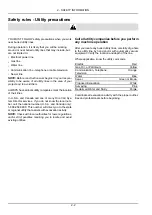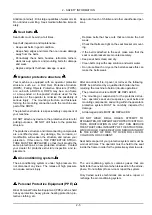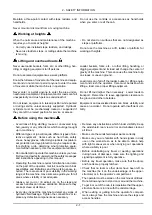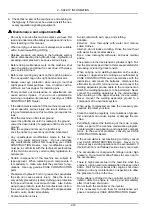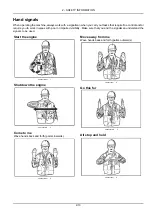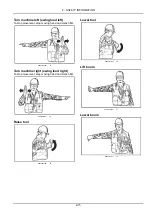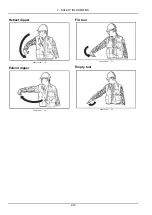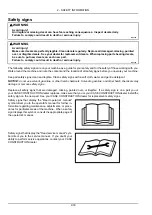
2 - SAFETY INFORMATION
Unsupported hydraulic cylinders can lose pressure and
drop the equipment, causing a crushing hazard. Do not
leave equipment in a raised position while parked or dur-
ing service, unless the equipment is securely supported.
Jack or lift the machine only at jack or lift points indicated
in this manual.
Incorrect towing procedures can cause accidents. When
you tow a disabled machine follow the procedure in this
manual. Use only rigid tow bars.
Stop the engine, remove the key, and relieve pressure
before you connect or disconnect fluid lines.
Stop the engine and remove the key before you connect
or disconnect electrical connections.
Scalding can result from incorrect removal of coolant
caps.
Cooling systems operate under pressure.
Hot
coolant can spray out if you remove a cap while the sys-
tem is hot. Allow the system to cool before you remove
the cap. When you remove the cap, turn it slowly to allow
pressure to escape before you completely remove the
cap.
Replace damaged or worn tubes, hoses, electrical wiring,
etc.
The engine, transmission, exhaust components, and hy-
draulic lines may become hot during operation. Take care
when you service such components. Allow surfaces to
cool before you handle or disconnect hot components.
Wear protective equipment when appropriate.
When welding, follow the instructions in the manual. Al-
ways disconnect the battery before you weld on the ma-
chine. Always wash your hands after you handle battery
components.
Fire and explosion prevention
Fuel or oil that is leaked or spilled on hot surfaces or elec-
trical components can cause a fire.
Crop materials, trash, debris, bird nests, or flammable
material can ignite on hot surfaces.
Always have a fire extinguisher on or near the machine.
Make sure that the fire extinguisher(s) is maintained and
serviced according to the manufacturer’s instructions.
At least once each day and at the end of the day, remove
all trash and debris from the machine especially around
hot components such as the engine, transmission, ex-
haust, battery, etc. More frequent cleaning of your ma-
chine may be necessary depending on the operating en-
vironment and conditions.
At least once each day, remove debris accumulation
around moving components such as bearings, pulleys,
belts, gears, cleaning fans, etc. More frequent cleaning
of your machine may be necessary depending on the
operating environment and conditions.
Inspect the electrical system for loose connections and
frayed insulation. Repair or replace loose or damaged
parts.
Do not store oily rags or other flammable material on the
machine.
Do not weld or flame cut any items that contain flammable
material. Clean items thoroughly with non-flammable sol-
vents before welding or flame-cutting.
Do not expose the machine to flames, burning brush, or
explosives.
Promptly investigate any unusual smells or odors that
may occur during operation of the machine.
Before performing maintenance for electrical systems or
electric welding, always place the key of the battery mas-
ter switch in “O” (Off) position or disconnect the negative
— terminal of the batteries, in order to cut off the electric
circuit.
General battery safety
Always wear eye protection when you work with batteries.
Do not create sparks or have open flame near a battery.
Ventilate the area when you charge a battery or use a
battery in an enclosed area.
Disconnect the negative — terminal first and reconnect
the negative — terminal last.
When you weld on the machine, disconnect both termi-
nals of the battery.
Do not weld, grind, or smoke near a battery.
When you use auxiliary batteries or connect jumper ca-
bles to start the engine, use the procedure shown in the
operator’s manual. Do not short across terminals.
Follow the manufacturer’s instructions when you store
and handle batteries.
Battery post, terminals, and related accessories contain
lead and lead compounds. Wash hands after handling.
Battery acid causes burns. Batteries contain sulfuric acid.
Avoid contact with skin, eyes, or clothing. Antidote (exter-
nal): Flush with water. Antidote (eyes): flush with water
for 15 minutes and seek medical attention immediately.
2-4
Summary of Contents for CX37C
Page 16: ...1 GENERAL INFORMATION 1 10...
Page 64: ...3 CONTROLS AND INSTRUMENTS Footrest SMIL16MEX1264BA 17 3 12...
Page 136: ...5 TRANSPORT OPERATIONS 5 8...
Page 200: ...6 MAINTENANCE 6 64...
Page 204: ...7 TROUBLESHOOTING 7 4...
Page 212: ...8 SPECIFICATIONS 8 8...













